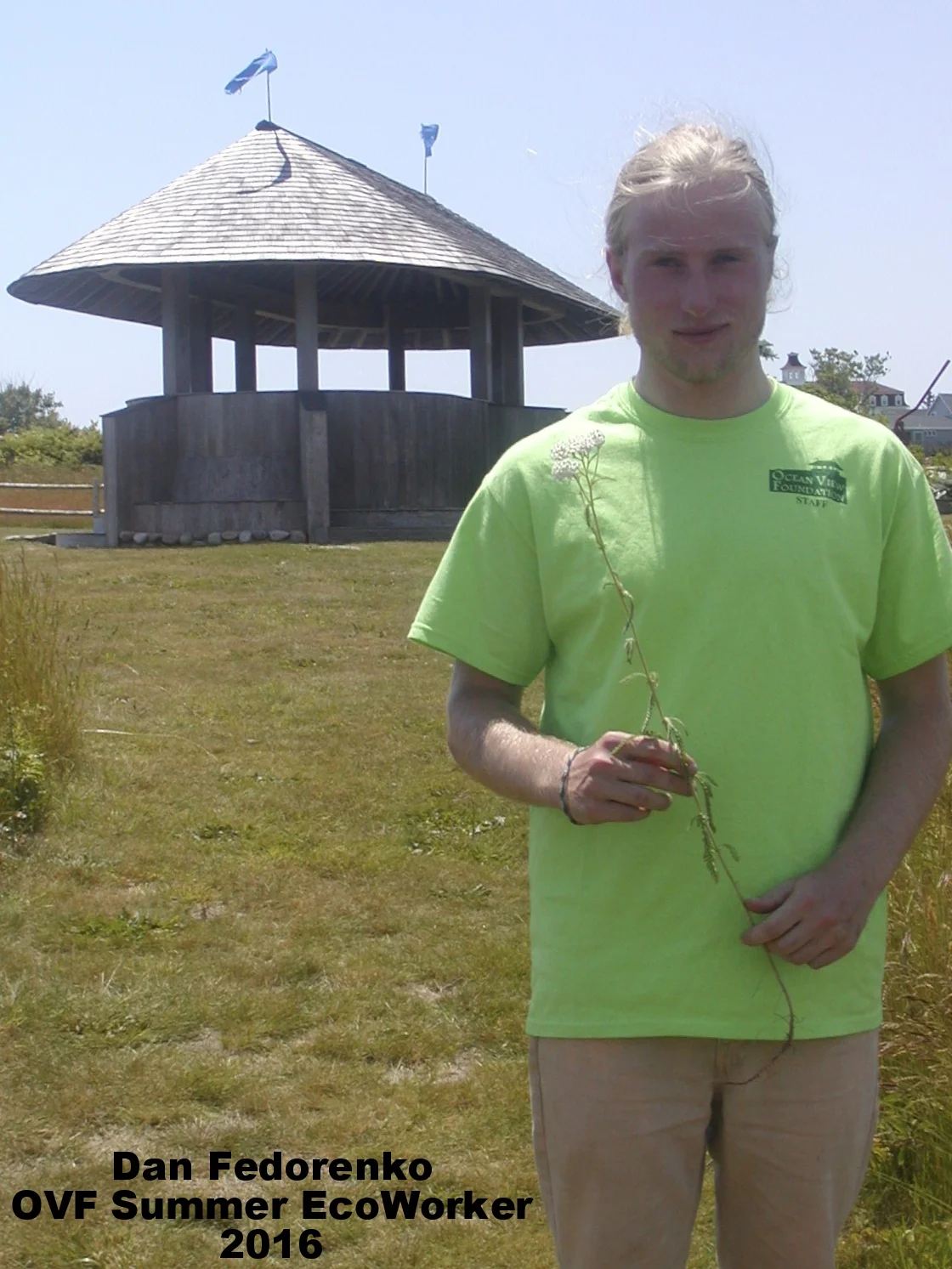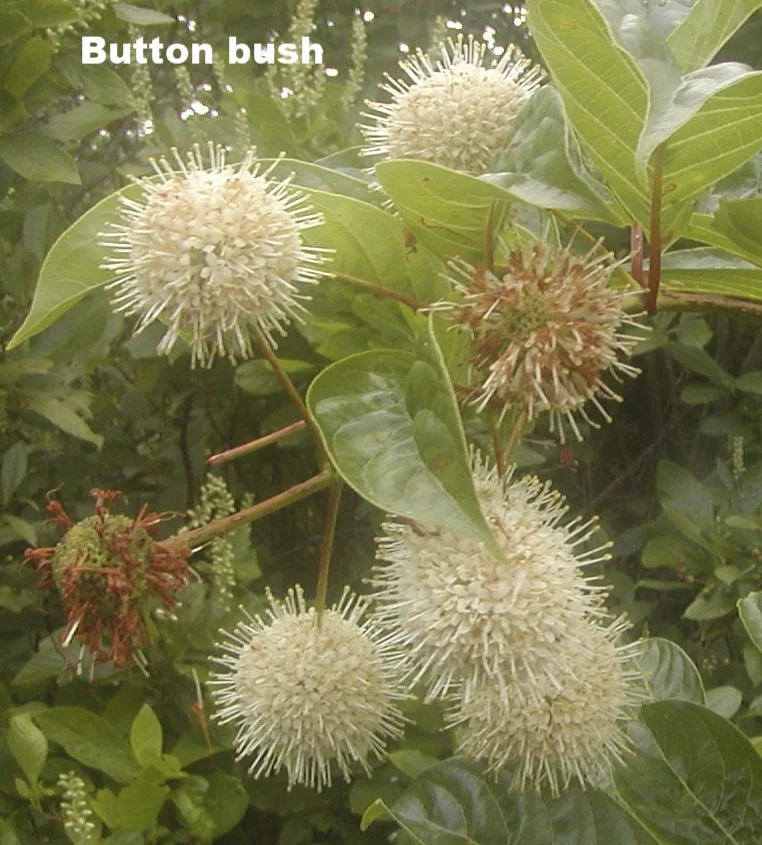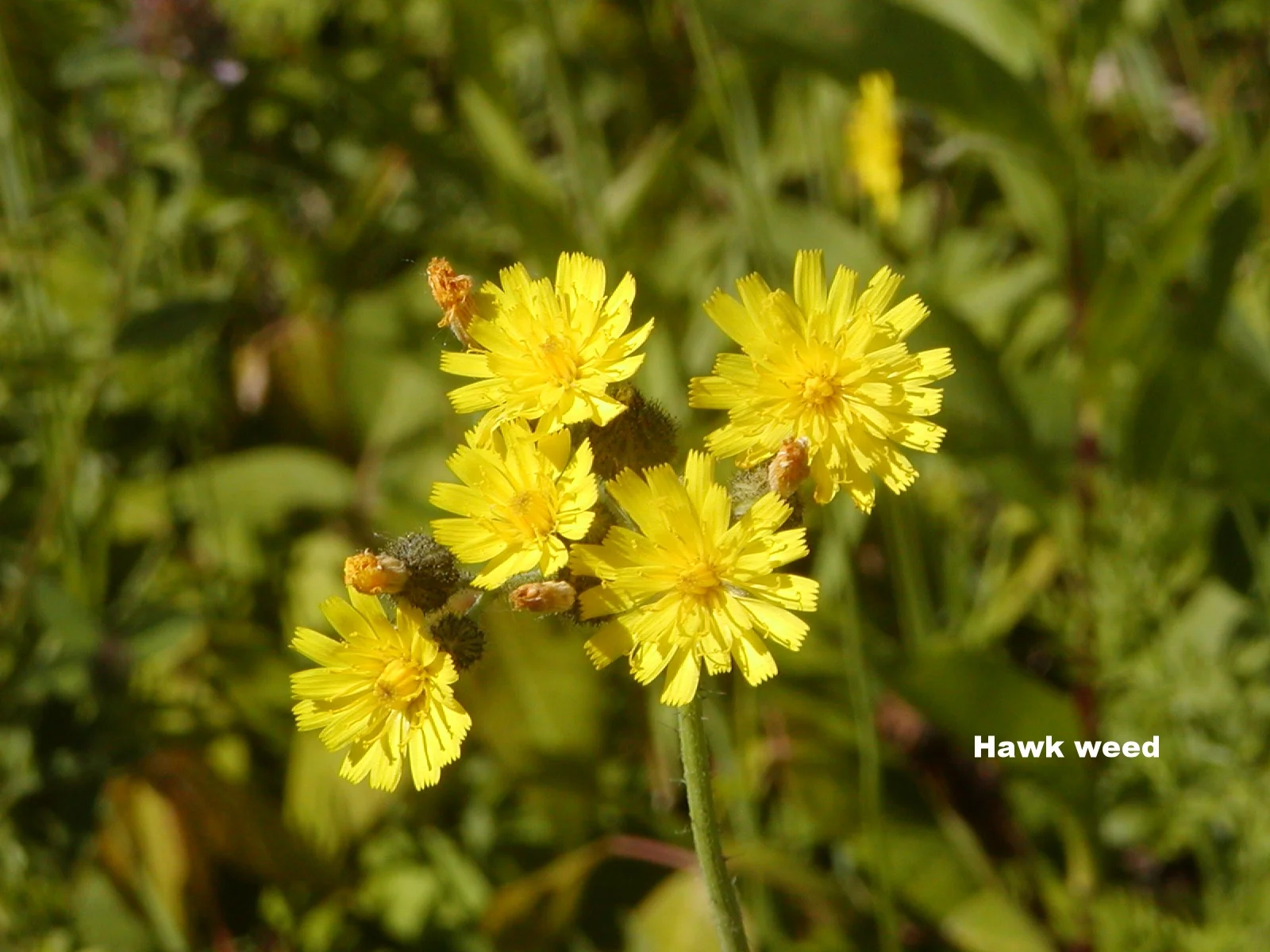
Dan Fedorenko, OVF's 2016 Summer EcoWorker
Dan is a junior at the University of Rhode Island. He has not decided what area of life science he wants to concentrate in, he has most recently worked with amphibians in the wetlands and vernal pools of RI. And this summer he will be making a study of Block Island's wildflowers.

Virgin's Bower: Flowers contain four petals that form an X. Male flowers have many white stamens, while the female flowers have green pistils at their center.

Early Goldenrod: Typically the first goldenrod to bloom, this goldenrod is seen on roadsides with its multiple arcs of numerous tiny yellow flowers. Early goldenrod can be distinguished from other goldenrods by the absence of hairs on the stem.

Swamp loosestrife has flowers that grow within the axils of the plant. After the flowers have passed they are replaced by seed capsules. This plant prefers wet to moist areas. Native.

Curly dock: Often growing in wet places, this weed is known for its dry fruiting head which is brown and stands erect. Invasive.

Virginia creeper is a vine that can grow over 30 feet. It has five green leaflets that turn red in the fall. This creates a wonderful contrast on stone walls. Native.

Nodding smartweed is often found growing in shallow marsh areas. Its racemes of dense flowers are often hanging. This plant is native, but can be quite weedy.

Button bush: This shrub can be found in swampy areas where there is plenty of water around. It is easily spotted by its spherical clusters of tiny white flowers. These flowers have a strong pleasant fragrance. Native.

Curly dock: Often growing in wet places, this weed is known for its dry fruiting head which is brown and stands erect. Invasive.


Spotted Touch-Me-Not: Red/yellow flower that is shaped like a cornucopia. Often found in wet areas.When the fruits (below and left of the flower in this photo) of the touch-me-not are touched they burst, releasing the seeds within.

Rabbits-foot clover
Rabbits-foot clover: Not as common as some other clovers, this clover can be found in fields and roadsides in large numbers. Its name comes from its resemblance of a rabbits foot. Many insects will feed on the foliage and bees will often stop by to pollinate the flowers. Redwing blackbirds and mourning doves will feed on the seeds. Non-native.

Asiatic bittersweet: This invasive vine uses everything in its path to grow upward on and receive the most amount of sunlight possible. This harms many other plants by smothering them. Asiatic bittersweet has a very high seed production which are often spread by birds, and humans who like their orange and yellow decorative seeds. Invasive.

Trumpet creeper: Given its name due to its flowers looking like trumpets. The flowers range from orange to red. This aggressive vine can grow over 30 feet high. Native to eastern North America.

Butterflyweed: The butterflyweed is part of the milkweed family, unlike the common milkweed there is no milky sap within the stem. The showy flowers have colors that can range from yellow to a beautiful orange/ amber. These flowers attract butterflies along with bees. Native Americans chewed the root of the butterflyweed as a cure for pleurisy. Native.

Poison Ivy: Poison Ivy is notorious for the rashes it gives people after they have come in contact with it. Even if the person did not come in direct contact, but only touched it with their shoes or clothing, the oil will stay wherever contact was made and can later cause rashes if touched. Poison Ivy can be spotted by its three leaf pattern. Its leaves are typically a bit shiny and sometimes have a red tint to them. Native.

Asiatic Dayflower: This annual plant has a unique flower that contains two blue petals and one white petal. The blue petals have a "true blue" color that isn't found in too many other plants. Many flowers that appear blue are actually closer to violet or purple. The asiatic dayflower interacts with many other species. It is pollinated by bees, its foliage is a food source for white tailed deer, and the seeds are eaten by certain birds like the redwing blackbird and mourning dove. Invasive.

Birdsfoot trefoil is a perennial herbaceous legume. The flowers are a bright yellow and have quite an irregular shape. Birdsfoot trefoil is often planted on roadsides to decrease wind and water erosion. It is also seeded in fields along with grass for livestock to graze upon. Certain animals such as the Canada goose, deer, and elk all enjoy eating it. Birdsfoot trefoil can be invasive in certain cases.

Queen Anne's Lace: Also known as wild carrot or birds nest, this plant is very common and fascinates most. The flowers grow in an umbral pattern creating a roof of white. Not always, but most of the time there is a single purple or red flower in the center. If you smell the root, it will smell just like a carrot.

Chicory: Chicory has a wonderful blue-purple flower. You can see that only a few flowers bloom at a time, this is because each bloom only lasts about a day. It can often be found in fields and on roadsides. The roots are often used in coffee to give a distinct taste, and the leaves are often used to cook with.
Privet: Privet is a shrub often planted to use as a hedge. Its flowers bloom in large erect groups creating cones of white. This flower has a sweet and quite strong aroma.

Deptford pink is a small plant, if it weren't for its deep pink color then it would be quite difficult to spot. Its flowers have 5 petals and if looked closely enough there are white spots on them. This plant is often found on the edge of paths and on the edge of roadsides.

Woody nightshade (a.k.a bittersweet nightshade) is a very attractive, but also very poisonous plant. It has deep purple petals with a bright yellow stamen in the center. It's berries are red and look quite appetizing however, all parts of this plant are poisonous and can prove to be fatal if ingested due to the toxic alkaloids found within it. Throughout history it has had many medicinal uses, and even today certain parts are still used. This plant is often confused with deadly nightshade. To tell the difference you can either look at the berries or at the center of the flowers petals. Woody nightshade has groups of red berries, whereas deadly nightshade has single purple berries. Within the center of the woody nightshade is a distinct yellow stamen, much larger and more distinct than the deadly nightshade. Invasive.

Common Milkweed is often seen as a large pesky garden weed, but it is also very important to many species of insects. It is easily spotted by its spherical clusters of flowers. These flowers have a very nice fragrance. If you break the stem of the plant you will find a milky sap. This sap is poisonous due to cardiac glycosides. Certain species such as the monarch butterfly use this poison as a natural defense system. When the monarch caterpillars eat the leaves of the milkweed the glycosides enter their body and make them poisonous. Even when the caterpillars become butterflies they will remain poisonous. This is only one of the many interactions that milkweed has with nature. Common milkweed is native.

Beach pea:
This coastal plant can be found on beaches and in dunes. It has dark purple flowers and green oval shaped leaves. This plant is native.

Everlasting pea:
This vine is often found on roadsides, within fields, and along fence rows. The irregular pink flowers are often bunched together. The seeds are poisonous. This plant has been naturalized in Rhode Island.

Japanese honeysuckle is easily spotted by its white and yellow flowers. Children particularly enjoy the honeysuckle because of the sweet nectar that can be sucked out of it. The honeysuckle produces small black berries which birds eat. This plant is invasive, grows quickly, and strangles other plants.

Arrowwood: This shrub is commonly found on Block Island. When it blooms (in late June and early July), there are large clusters of small white flowers. The name Arrowwood comes from the Native American's use of its straight branches as arrow shafts.

Multiflora rose
Multiflora Rose is an invasive vine that can be found all over Block Island. It can be easily spotted by its numerous white blossoms which bloom early in the summer. These blossoms create a wondeful fragrance. One of the concerning issues with multiflora rose is that it forms dense thickets which prevent other plants from growing.

Multiflora rose

Beach rose a.k.a. Rosa rugosa
Beach rose, often referred to by its scientific name "Rosa rugosa" (wrinkled rose), is another common rose of Block Island. These roses are naturalized invasives as well. It is often found near the coastline within dunes where it's bright pink (or pale pink or white) petals stand out.

Dandelion
The familiar dandelion is a favorite for most. It's gold-yellow color often decorates open fields and the sides of roads. If you're having trouble identifying whether it is or isn't a dandelion, then there is an easy way to check. Towards the bottom of the plant there are jagged lobed leaves.

Hawkweed
The hawkweed is very similar in appearance to the dandelion and is often found nearby. Both the dandelion and hawkweed are in the daisy family, and are invasive. The hawkweed is more of a lemon-yellow color rather than the dandelions gold-yellow color. Trying to tell the two apart by color can sometimes be tricky. A better way to tell is to check the leaves at the bottom of the plant. The hawkweed has smooth leaves, whereas the dandelion's leaves are jagged.

Hawkweed leaves (mostly smooth), found at the base of the stem.

Dandelion leaves (mostly jagged) found at the base of the stem.




































